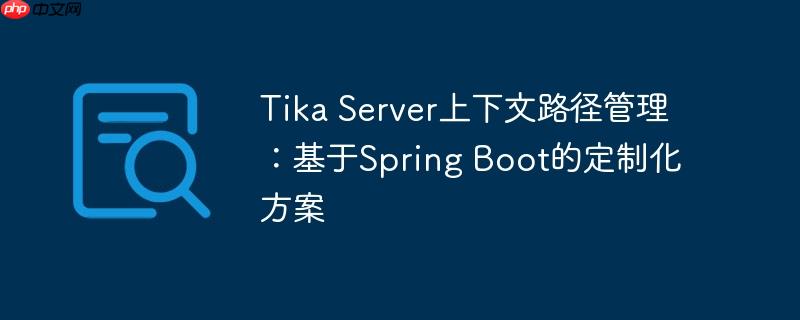
在现代微服务架构中,特别是在openshift或kubernetes等容器编排平台部署应用时,通常需要通过上下文路径(context path)来区分同一域名下的不同服务。例如,https://my-openshift-instance.com/my-first-service 和 https://my-openshift-instance.com/tika-server 分别指向不同的后端服务。
对于Spring Boot应用,配置上下文路径非常直接,只需在application.properties或application.yml中设置server.servlet.context-path=/your-service-name即可。然而,Apache Tika Server的官方Docker镜像并非基于Spring Boot构建,其官方文档、Docker仓库及Tika主仓库中均未提供直接配置上下文路径的选项。这给希望在共享域名下部署Tika Server并为其指定特定上下文路径的用户带来了挑战。
鉴于官方Tika Server镜像无法直接满足上下文路径配置的需求,一种有效的替代方案是构建一个轻量级的Spring Boot MVC应用,并在其中集成Apache Tika的核心解析功能。这种方法不仅允许完全控制应用的上下文路径,还能根据实际需求定制Tika的功能。
首先,创建一个标准的Spring Boot项目。可以使用Spring Initializr(start.spring.io)快速生成项目骨架,选择Spring Web作为核心依赖。
关键在于添加Apache Tika的解析器依赖。在pom.xml中,需要引入tika-parsers,它包含了Tika进行文档内容类型检测和解析所需的所有核心组件。
<?xml version="1.0" encoding="UTF-8"?>
<project xmlns="http://maven.apache.org/POM/4.0.0" xmlns:xsi="http://www.w3.org/2001/XMLSchema-instance"
xsi:schemaLocation="http://maven.apache.org/POM/4.0.0 https://maven.apache.org/xsd/maven-4.0.0.xsd">
<modelVersion>4.0.0</modelVersion>
<parent>
<groupId>org.springframework.boot</groupId>
<artifactId>spring-boot-starter-parent</artifactId>
<version>3.2.5</version> <!-- 或更高版本 -->
<relativePath/> <!-- lookup parent from repository -->
</parent>
<groupId>com.example</groupId>
<artifactId>tika-custom-service</artifactId>
<version>0.0.1-SNAPSHOT</version>
<name>tika-custom-service</name>
<description>Custom Tika Service with Context Path</description>
<properties>
<java.version>17</java.version>
</properties>
<dependencies>
<dependency>
<groupId>org.springframework.boot</groupId>
<artifactId>spring-boot-starter-web</artifactId>
</dependency>
<!-- Apache Tika Parsers -->
<dependency>
<groupId>org.apache.tika</groupId>
<artifactId>tika-parsers</artifactId>
<version>2.9.2</version> <!-- 请使用最新稳定版本 -->
</dependency>
<dependency>
<groupId>org.springframework.boot</groupId>
<artifactId>spring-boot-starter-test</artifactId>
<scope>test</scope>
</dependency>
</dependencies>
<build>
<plugins>
<plugin>
<groupId>org.springframework.boot</groupId>
<artifactId>spring-boot-maven-plugin</artifactId>
</plugin>
</plugins>
</build>
</project>在src/main/resources/application.properties或application.yml文件中,设置所需的上下文路径。
application.properties:
server.servlet.context-path=/tika-server server.port=8080
application.yml:
server:
port: 8080
servlet:
context-path: /tika-server创建一个Spring MVC的REST控制器,用于接收文件并利用Tika进行处理。以下示例展示了如何实现一个简单的端点来检测上传文件的内容类型。
import org.apache.tika.Tika;
import org.springframework.http.MediaType;
import org.springframework.http.ResponseEntity;
import org.springframework.web.bind.annotation.PostMapping;
import org.springframework.web.bind.annotation.RequestMapping;
import org.springframework.web.bind.annotation.RequestParam;
import org.springframework.web.bind.annotation.RestController;
import org.springframework.web.multipart.MultipartFile;
import java.io.IOException;
@RestController
@RequestMapping("/api/tika") // 控制器级别的路径,可根据需要调整
public class TikaServiceController {
private final Tika tika = new Tika(); // Tika实例通常是线程安全的,可以重用
/**
* 检测上传文件的内容类型
* @param file 待检测的Multipart文件
* @return 文件的MIME类型
* @throws IOException 如果文件处理失败
*/
@PostMapping(value = "/detect-content-type", consumes = MediaType.MULTIPART_FORM_DATA_VALUE)
public ResponseEntity<String> detectContentType(@RequestParam("file") MultipartFile file) throws IOException {
if (file.isEmpty()) {
return ResponseEntity.badRequest().body("No file provided for content type detection.");
}
try {
// 使用Tika检测文件的内容类型
String detectedContentType = tika.detect(file.getInputStream());
return ResponseEntity.ok(detectedContentType);
} catch (IOException e) {
// 记录错误并返回适当的错误响应
System.err.println("Error detecting content type: " + e.getMessage());
return ResponseEntity.internalServerError().body("Failed to detect content type: " + e.getMessage());
}
}
// 还可以添加其他Tika功能,例如提取文本或元数据
// @PostMapping(value = "/extract-text", consumes = MediaType.MULTIPART_FORM_DATA_VALUE)
// public ResponseEntity<String> extractText(@RequestParam("file") MultipartFile file) throws Exception {
// if (file.isEmpty()) {
// return ResponseEntity.badRequest().body("No file provided for text extraction.");
// }
// try (InputStream stream = file.getInputStream()) {
// String extractedText = new Tika().parseToString(stream);
// return ResponseEntity.ok(extractedText);
// } catch (Exception e) {
// System.err.println("Error extracting text: " + e.getMessage());
// return ResponseEntity.internalServerError().body("Failed to extract text: " + e.getMessage());
// }
// }
}现在,您的服务将在http://localhost:8080/tika-server/api/tika/detect-content-type(假设在本地运行)上可用,其中/tika-server是您定义的上下文路径。
将这个Spring Boot应用打包成可执行JAR文件,然后构建一个Docker镜像。
Dockerfile示例:
# 使用官方OpenJ9作为基础镜像,体积更小 FROM eclipse-temurin:17-jre-alpine # 设置工作目录 WORKDIR /app # 将构建好的JAR文件复制到容器中 COPY target/tika-custom-service-0.0.1-SNAPSHOT.jar app.jar # 暴露Spring Boot应用默认端口 EXPOSE 8080 # 启动应用 ENTRYPOINT ["java", "-jar", "app.jar"]
构建Docker镜像: docker build -t my-tika-custom-service:1.0 .
然后,您可以将此镜像推送到容器注册表(如Docker Hub或OpenShift的内部注册表),并像部署其他任何Spring Boot应用一样,将其部署到OpenShift或Kubernetes集群中。在OpenShift中,您的路由(Route)可以简单地指向此服务的/tika-server路径。
优势:
考量:
尽管Apache Tika Server的官方Docker镜像在上下文路径配置方面存在局限性,但通过构建一个定制化的Spring Boot MVC应用,并集成Tika的核心解析库tika-parsers,可以有效地解决这一问题。这种方法不仅提供了灵活的上下文路径控制,还允许开发者根据具体业务需求,定制和扩展Tika的功能,使其更好地融入现有的微服务架构中。在选择此方案时,应权衡其带来的开发灵活性与额外的开发维护成本。
以上就是Tika Server上下文路径管理:基于Spring Boot的定制化方案的详细内容,更多请关注php中文网其它相关文章!

每个人都需要一台速度更快、更稳定的 PC。随着时间的推移,垃圾文件、旧注册表数据和不必要的后台进程会占用资源并降低性能。幸运的是,许多工具可以让 Windows 保持平稳运行。

Copyright 2014-2025 https://www.php.cn/ All Rights Reserved | php.cn | 湘ICP备2023035733号